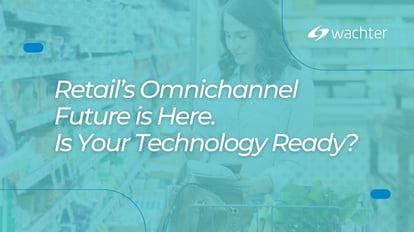The omnichannel revolution has been the future of retail for over a decade. Since the early 2010's, omnichannel has been at the forefront of retail strategy  as online sales began working in tandem with brick-and-mortar. Today, one thing is certain: the future is here, and if you don’t have a cohesive technology strategy surrounding it, your organization is a step behind industry leaders.
as online sales began working in tandem with brick-and-mortar. Today, one thing is certain: the future is here, and if you don’t have a cohesive technology strategy surrounding it, your organization is a step behind industry leaders.
Despite the growing popularity of e-commerce, in-store shoppers are looking for more than just transactions. They seek an experience that goes beyond the purchase. Retailers can enhance their omnichannel approach by integrating in-store technology seamlessly into the buyer journey. This approach capitalizes on physical locations and leverages the data that flows through their aisles, providing a unique and personalized shopping experience.
Built on the backbone of your in-store technology integrations, retailers who have focused on the hardware and software to best optimize this cross-channel customer experience are provided deeper insights into their customers shopping patterns. They're rewarded with terabytes of data encompassing everything from customer trends, shopper behaviors, as well as, backend merchandising data such as when specific products need to be restocked or aisles cleaned and employee and customer safety.
However, none of the above can take place if your technology is not up to the challenge.
Optimize Your In-Store Tech for Better Data
In order to achieve omnichannel harmony in this sales arena, organizations need to develop their customer experience. According to eMarketer, “the physical store is the next major media channel,” and that major media channel may feature three main types of technology integrations to leverage.
- Sensors
- WIFI and Beacons
- Screens, Kiosks, Interactive Displays
Integrating each of these solutions allows you to provide an optimal shopping experience while harnessing vast amounts of data allowing better business decisions. But what are the benefits of each of the above areas? Do retailers really need to invest in all of them and, if so, how do they work together? Let’s focus on the three technologies listed above.
Sensors
Sensors placed throughout stores provide information on customer flow and engagement. They provide the ability to leverage in-store ad views, determine how many customers visit specific sections at specific times, and count the amount of product interactions.
Network + WiFi Bluetooth Beacons
By integrating beacons and Bluetooth sensors into your stores network, you now have the ability to track customer movement patterns and specific locations within stores. Additionally, optimizing your network to include passive WiFi provides tracking of customer zones without needing an app download.
Digital Signage + Displays
Traditional in-store displays can receive a 21st century upgrade to include digital signage built within the cooler doors of the frozen food aisle while interactive kiosks and displays elsewhere in the store provide product information alongside the ability to make purchases or receive coupons. Additionally, this signage, paired with an IoT network provides data on most engaged items, dwell times in store zones, and most purchased items by display.
As the physical store evolves alongside the technology, retailers are able to harness better data, for more customer-centric decision making and a more targeted approach per location. However, there is still a catch for executing these plans.
Refine Your Network for Better Connection
In order for these efforts to work, retailers need a cohesive technology system working behind the scenes to support them. A robust network of integrated IoT components is imperative, ensuring that each piece of technology works together to keep your customers engaged.
This optimization starts with your network. One hiccup, meaning something as small as an access point wired into the wrong spot, and your whole system comes crashing down. With an unoptimized system you risk so much more than providing just an average customer experience. Picture worst case scenario: your signage and kiosks don't run as efficiently, you’re in-store app features are no longer enhancing your customers experience, and you’ve lost the customer data tracking that was happening alongside your beacons and sensors.
On the other hand, with an optimized network, your customers don’t even notice most of the technology in your store. They recognize that they had a pleasant experience and were probably enthused by some of your in-store advertising while you harnesses valuable data to continue building on that enhanced customer experience.
Efficient Deployment Through Trusted Partners
As you embark on this journey of transforming your infrastructure to elevate your omnichannel strategy, remember that the heartbeat of innovation lies in optimization.
When it comes to integrating these technologies that work in the background to revolutionize customer experiences, retailers need a partner they can trust that has the track record of leading other retailers through this digital transformation. At Wachter, our coast-to-coast team is nearly 2,000 strong of certified technicians ready to deploy at a moment’s notice.
Are you hoping to provide your customers with an enhanced experience while harnessing the most valuable customer data? Whether you're looking to just upgrade your infrastructure at a few locations or implement a next-gen solution across thousands of stores, our team is ready to assist.


